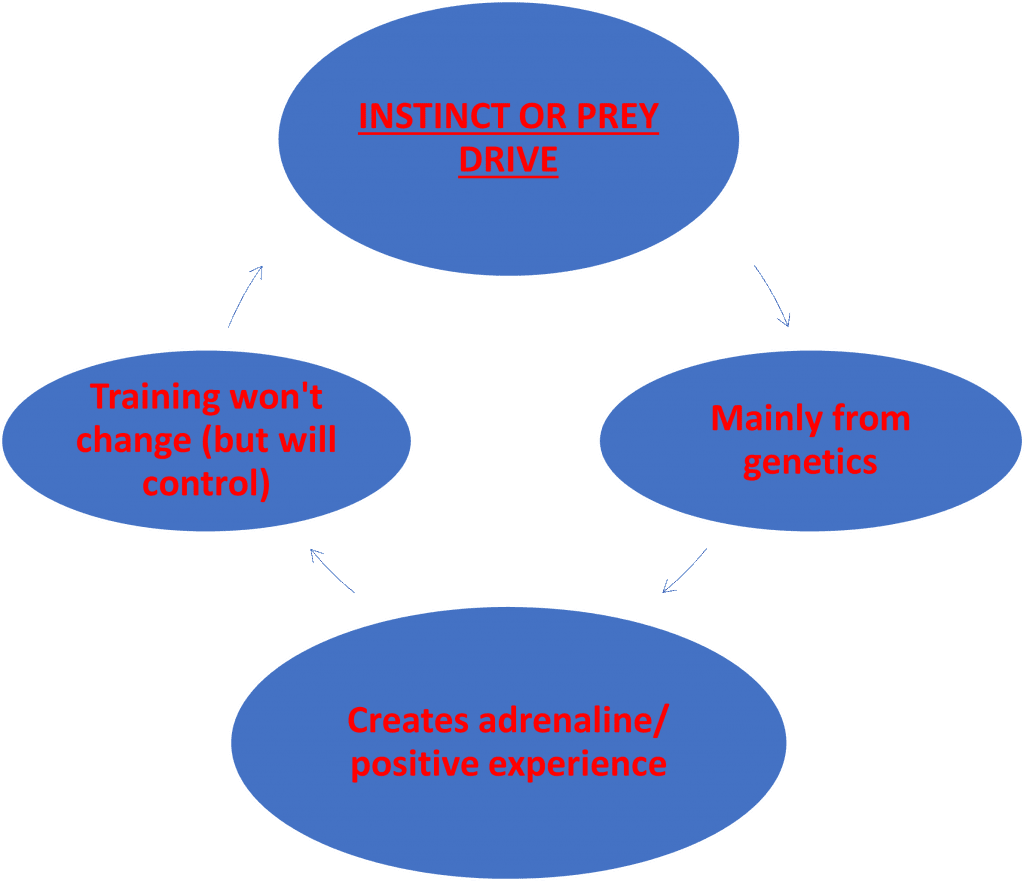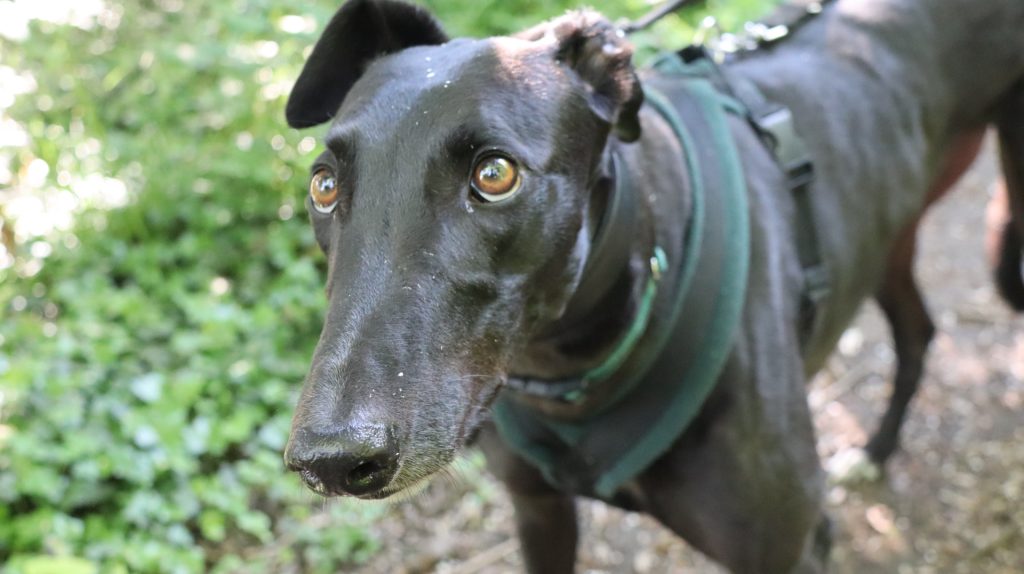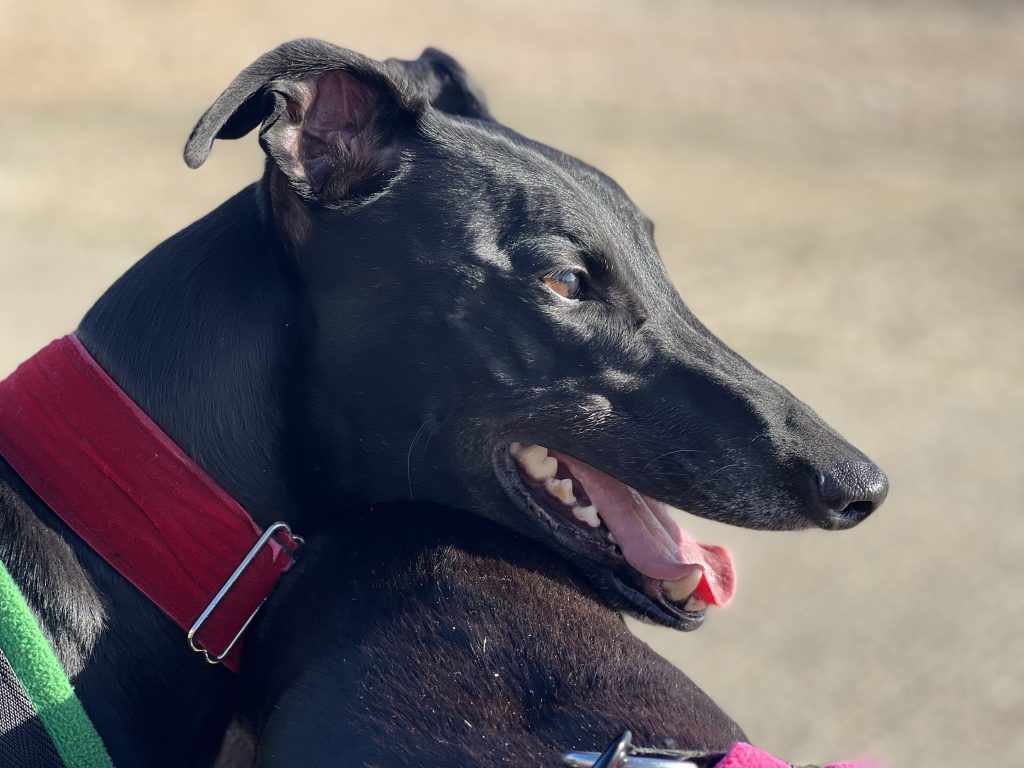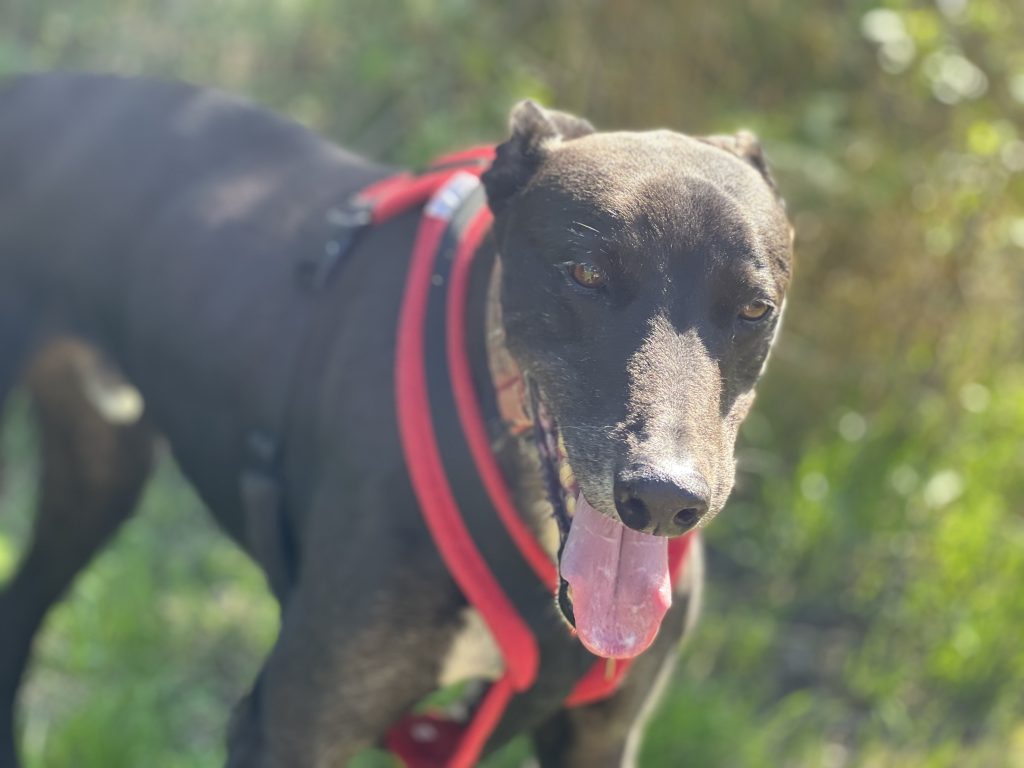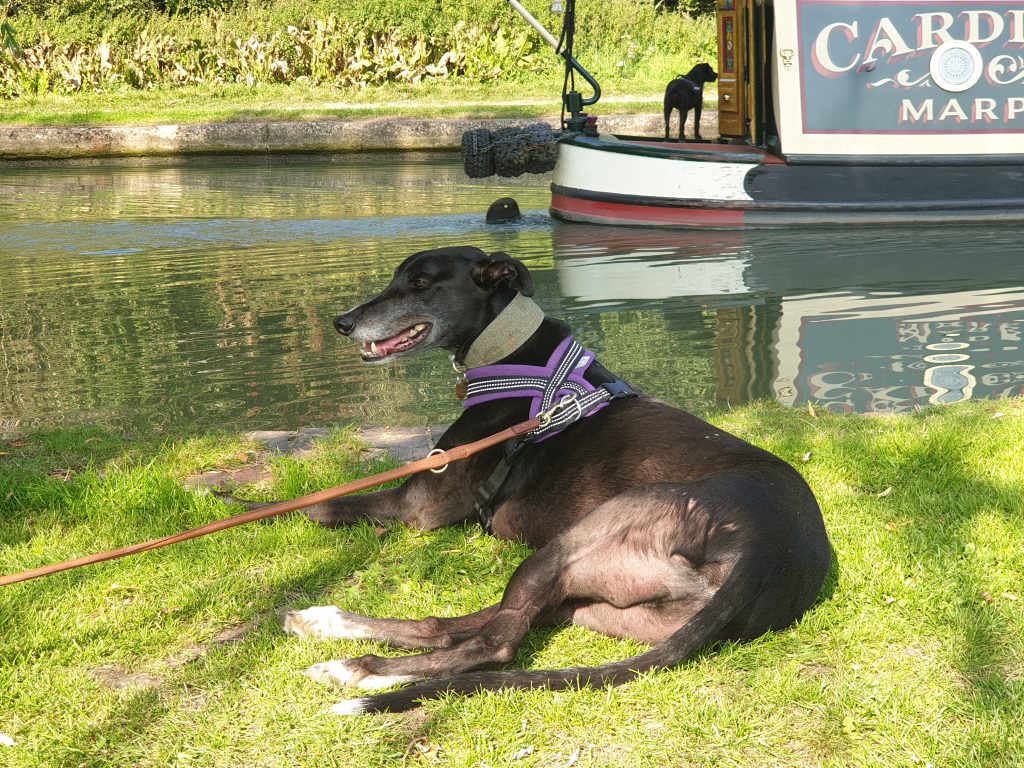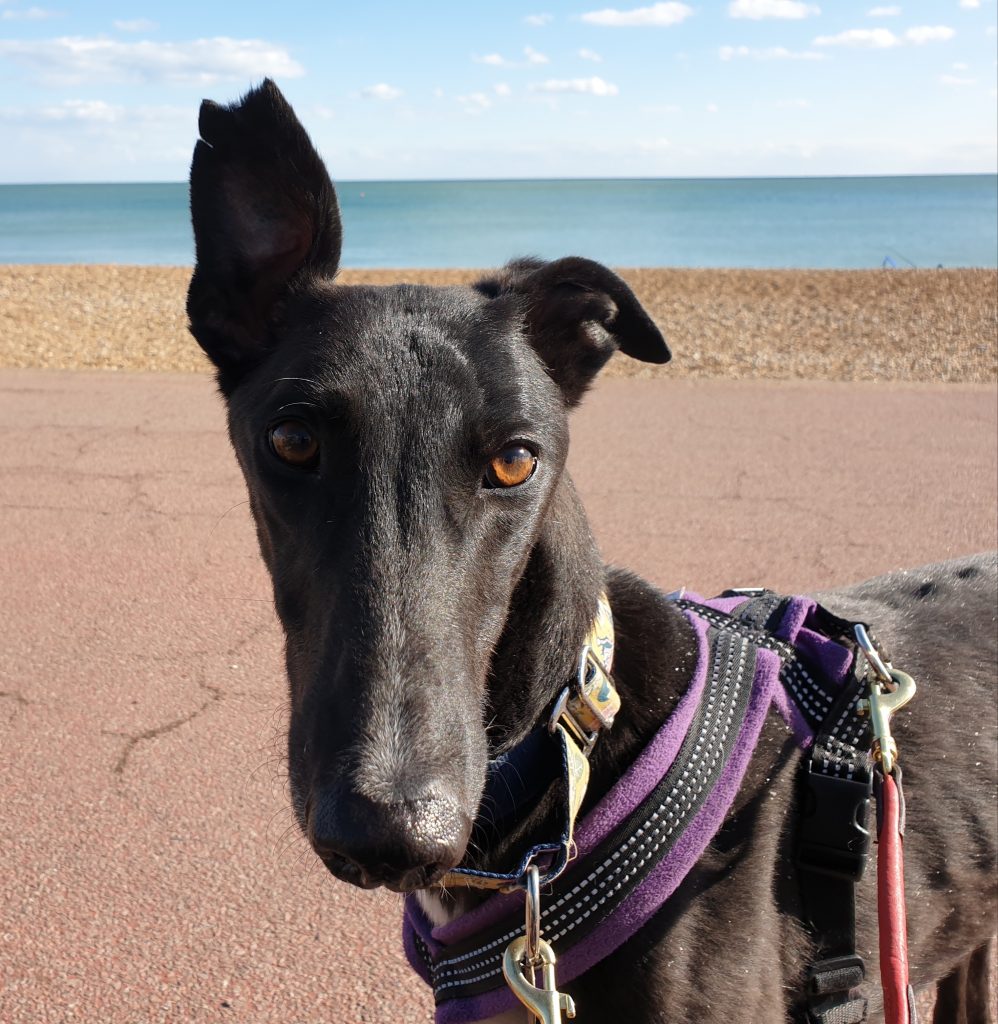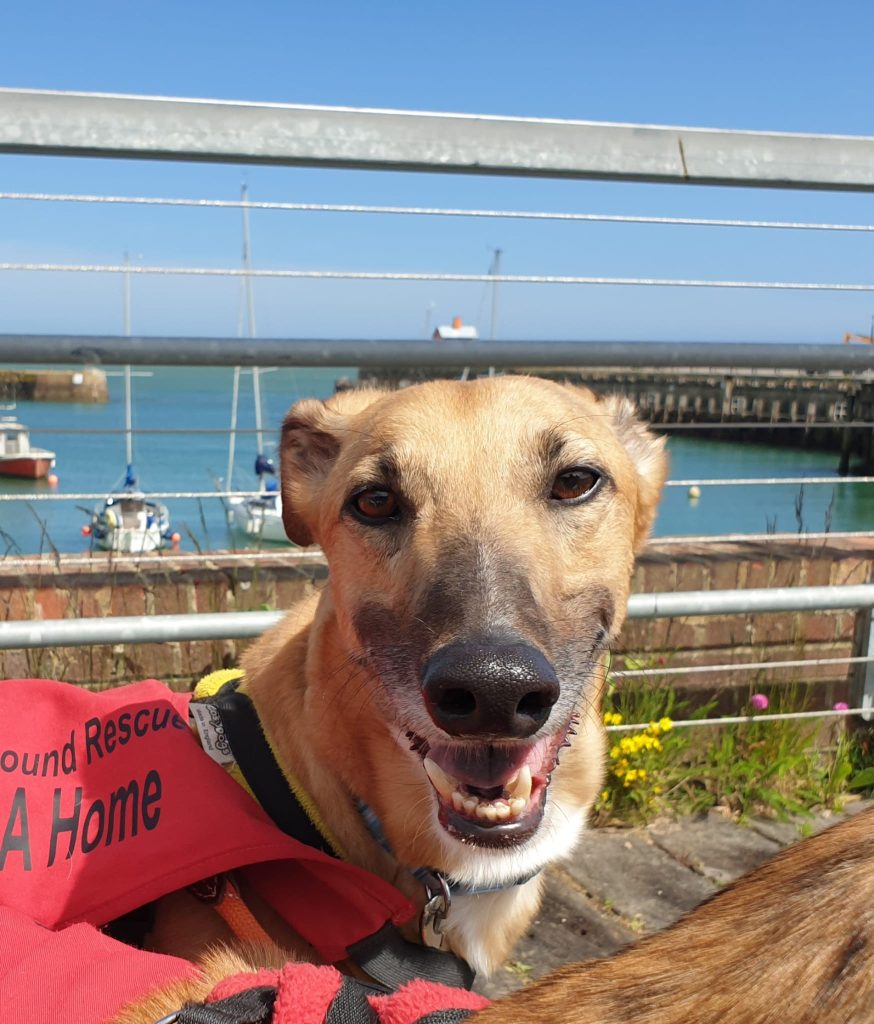You may be taken unawares as your dog may display no warning signs or mood changes. He may slink up to his prey and attack – in the same way lions do. There is no noise, no barking, no jumping about.
And don’t forget instinct is a positive experience – they are enjoying the moment – they are not being naughty.
Your Greyhound Has Been Trained To Chase Greyhound Instinct
All greyhound and lurcher owners need to understand instinct and manage it correctly.
A correctly fitting muzzle is the easiest way to do this as, training does not stop instinct. It may control your dogs instinct, but only until you are not looking or a small dog races past. We explain more about muzzles here.
We also strongly recommend you use a harness and double lead.
What does this mean for my greyhound?
In plain English, for our lovely greyhounds, instinct makes the prey drive work.
DO NOT be fooled by the dozy, plodding along exterior of a laid back and lazy greyhound. A dope on a rope greyhound can liven up in a split second if his instinct kicks in. He may not – but he may – and not knowing means you have to be aware.
But my dog lives happily and safely with cats!
Beware! A greyhound who lives happily with cats, can chase a cat outdoors.
You can have a greyhound with a very low prey drive who lives safely with cats – but one day instinct may wake up that prey drive and he may chase the neighbour’s cat. Because greyhounds are so fast – chase can equal seriously harm.
Greyhounds, lurchers and other sighthounds have instinct and prey drive in their DNA – it is what made them good at their pre-rescue life. The less instinct – the more chance they had of being “dismissed from work” at a younger age.
Therefore most younger greyhounds can be cat trained – because their prey drive was not strong enough to be successful. A top-class greyhound has to be a excellent athlete, have his prey drive motivated to chase (training) and be instinctive.
Prey drive is the motivation to chase and/or kill – also known as predatory aggression. It is a completely natural behaviour, and all dogs have it. It is not your dog being naughty or aggressive.
It must be kept under control and that is your job.
You may be taken unawares as your dog may display no warning signs or mood changes. He may slink up to his prey and attack – in the same way lions do. There is no noise, no barking, no jumping about.
And don’t forget instinct is a positive experience – they are enjoying the moment – they are not being naughty.
Instinct is different from lead aggression and reactivity
Do you test the dogs for instinct?
We are unable to test for instinct – it may lie dormant and appear when the conditions are right for chase. We can test for prey drive (hence how we now if a dog is cat workable).
Is my dogs instinct the same as aggression?
Everyone also needs to understand that instinct is not aggression. A dog who chases a cat or another dog will not harm a child.
Your greyhound was born with a strong genetic instinct to chase and kill prey. He has the potential, without warning, to instinctively grab and kill a small animal, without thinking. He is not doing this because he is aggressive or naughty – he is doing it because his instinct tells him to, in the same way a border collie may suddenly chase sheep.
Surely it’s obvious ….., but owners invariably spit out their tea when it is mentioned and point at their adored greyhound with disbelief. The greyhound is upside down on the sofa, wearing pyjamas with a dinosaur pattern, and only ever runs as far as the fridge.
It is important for a greyhound owner to understand the impact of his early racing training
In the racing industry this instinct to chase prey was reinforced to ensure that the greyhound was using this instinct to its full effect. He underwent training to chase and kill (sometimes illegally with live animals), and he may have been kennelled for up to 23 hours a day so that this training was his only purpose in life. He learned his job and he may have even enjoyed it.
When your greyhound arrives in your home it is important to understand that the instinct to chase and kill is part of him, no matter how hard it is to believe.
- There is no re-set button,
- He has not ‘left his old life behind him’,
- And he has not had enough of running.’.
If you are not very careful, his instinct to chase and kill might have a devastating impact on the animal he chases. If he chases or kills a family pet, such as a small dog loved by children, you might devastate the whole life of a family.
Your new greyhound must always be on a lead and wear a muzzle in public. Please read our separate section on Muzzle up – love your muzzle.
The instinct to catch prey is present in all greyhounds, including:
- A greyhound that is visibly excited (reactive) when he sees other animals, such as rabbits and squirrels or other dogs.
- A sofa hound that has never shown interest in other animals.
Your lovely very laid back, sofa hogging hound may never chase – he may barely move quickly unless biscuits are involved and he may walk at the speed of a tortoise. BUT – it just takes a spilt section for instinct to kick up – for his genes and his past training to wake up and at this point he will chase and he may kill.
The problem with instinct is – we cannot assess for it – and you cannot test for it. It can lie dormant for years and appear at the wrong time, when a small fluffy dog is off lead in the park.
A few important things to remember:
- Instinct is different to prey drive. A greyhound who has failed at racing – and who lives happily with cats – will have a low prey drive. BUT they still have instinct and they could still kill cats outside.
- Instinct and prey drive are both different to reactivity.
NEVER take chances – protect your dog, protect other animals and be a responsible owner.
KGR recommend that you ALWAYS walk your new dog using a harness double lead and muzzle for at least the first 3 months. This will give you a chance to monitor how your dog reacts
We always recommend all new dogs are walked in public on a correctly fitting harness, a double lead (attached to both the harness and the collar) a correctly fitting sighthound collar and a muzzle. This should be for a minimum of 3 months. We sell all of these items in our online shop
The control of dogs act states you must be in control of your dog in a public place.
Everyone at Kent Greyhound Rescue is a volunteer. Our online shop really helps us to pay our kennel and vets bills. We sell everything you need for your dog and all proceeds help the rescue.
